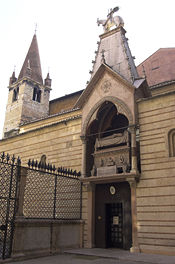
Santa Maria Antica
Encyclopedia

Verona
Verona ; German Bern, Dietrichsbern or Welschbern) is a city in the Veneto, northern Italy, with approx. 265,000 inhabitants and one of the seven chef-lieus of the region. It is the second largest city municipality in the region and the third of North-Eastern Italy. The metropolitan area of Verona...
, Italy. The current church is Romanesque
Romanesque architecture
Romanesque architecture is an architectural style of Medieval Europe characterised by semi-circular arches. There is no consensus for the beginning date of the Romanesque architecture, with proposals ranging from the 6th to the 10th century. It developed in the 12th century into the Gothic style,...
in style and dates to 1185, rebuilt after the earthquake of 1117 destroyed the original building that dated back to the end of the period of Lombard domination in the 7th century. The only surviving remains of the 7th century building is a fragment of black and white mosaic floor.
The current building was dedicated by the patriarch of Aquileia
Patriarch of Aquileia
The Patriarch of Aquileia was an office in the Roman Catholic Church. During the Middle Ages the Patriarchate of Aquileia was a temporal state in Northern Italy. The Patriarchate of Aquileia as a church office was suppressed in 1752....
and acted as the private chapel of Verona's ruling Scaligeri family, located beside their family cemetery (the site of the 13th century Scaliger Tombs
Scaliger Tombs
The Scaliger Tombs is a group of five Gothic funerary monuments in Verona, Italy, celebrating the Scaliger family, who ruled in Verona from the 13th to the late 14th century....
). The church has a small tuff
Tuff
Tuff is a type of rock consisting of consolidated volcanic ash ejected from vents during a volcanic eruption. Tuff is sometimes called tufa, particularly when used as construction material, although tufa also refers to a quite different rock. Rock that contains greater than 50% tuff is considered...
bell tower in a purely Romanesque style, with mullion
Mullion
A mullion is a vertical structural element which divides adjacent window units. The primary purpose of the mullion is as a structural support to an arch or lintel above the window opening. Its secondary purpose may be as a rigid support to the glazing of the window...
ed windows and a brick-covered spire. Around 1630 the three-nave interior was altered to the Baroque
Baroque architecture
Baroque architecture is a term used to describe the building style of the Baroque era, begun in late sixteenth century Italy, that took the Roman vocabulary of Renaissance architecture and used it in a new rhetorical and theatrical fashion, often to express the triumph of the Catholic Church and...
style, though a restoration at the end of the 19th century restored the original Romanesque interior, divided by columns with "sesto rialzato" arches, and with an "incavallature" roof supported by transverse arches, as at the basilica of San Zeno. There are two lateral apses in tuff and cotto, and a central apse with two early 14th century frescoes.
The exterior has alternate bands of tuff
Tuff
Tuff is a type of rock consisting of consolidated volcanic ash ejected from vents during a volcanic eruption. Tuff is sometimes called tufa, particularly when used as construction material, although tufa also refers to a quite different rock. Rock that contains greater than 50% tuff is considered...
and cotto, with small windows. The side-door is dominated by the arch of Cangrande I della Scala
Cangrande I della Scala
Cangrande della Scala was an Italian nobleman, the most celebrated of the della Scala family which ruled Verona from 1277 until 1387. Now perhaps best known as the leading patron of the poet Dante Alighieri, Cangrande was in his own day chiefly acclaimed as a successful warrior and autocrat...
, the soberest but most monumental of the family arches. Excavations have found a cemetery near the church, containing fifty 11th century burials, some aligned north-south, some east-west.
Burials
- Alberto I della ScalaAlberto I della ScalaAlberto I della Scala was lord of Verona from 1277, a member of the Scaliger family.The son of Jacopino della Scala, he was podestà of Mantua in 1272 and 1275. In 1277, after the assassination of his brother Mastino, inherited the seigniory of Verona.Alberto died in Verona in 1301. His son...
- Cangrande I della ScalaCangrande I della ScalaCangrande della Scala was an Italian nobleman, the most celebrated of the della Scala family which ruled Verona from 1277 until 1387. Now perhaps best known as the leading patron of the poet Dante Alighieri, Cangrande was in his own day chiefly acclaimed as a successful warrior and autocrat...
- Mastino II della ScalaMastino II della ScalaMastino II della Scala was lord of Verona. He was a member of the famous Scaliger family of northern Italy.He was the son of Alboino I della Scala and Beatrice da Correggio. At the death of Cangrande I, he and his brother Alberto II were associated in the rule of Verona. Soon, however, Mastino's...
- Cansignorio della ScalaCansignorio della ScalaCansignorio della Scala was Lord of Verona from 1359 until 1375, initially together with his brother Paolo Alboino.-Biography:...
- Alberto II della ScalaAlberto II della ScalaAlberto II della Scala was lord of Verona from 1329 until his death. He was a member of the famous Scaliger family of northern Italy....

